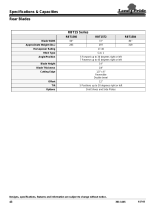Page
CONTENTS
1. PRODUCT NAME .............................................................................................................................. 1
2. MARKETING OBJECTIVE ................................................................................................................ 1
3. APPLICATIONS ................................................................................................................................. 1
4. SELLING POINTS ............................................................................................................................. 1
4-1. Selling Point Descriptions ...................................................................................................................2
5. SPECIFICATIONS ............................................................................................................................. 4
6. COMPARISONS WITH SIMILAR PRODUCTS ................................................................................. 5
7. PRECAUTIONS IN SALES PROMOTION ........................................................................................ 6
7-1. Instruction Manual ..............................................................................................................................6
7-2. Warning Labels and Caution Labels ...................................................................................................6
7-3. Relative Standards .............................................................................................................................8
7-4. Laser Marker (Only Model C 10FCH) .................................................................................................8
7-5. Ambient illuminance and Visibility of Laser Line (Only Model C 10FCH) ...........................................9
8. ADJUSTMENT AND OPERATION PRECAUTIONS ....................................................................... 10
8-1. Position Adjustment of Laser Line (Only Model C 10FCH) ............................................................... 10
8-2. How to Use the Vise Assembly ......................................................................................................... 11
8-3. Confirmation for Use of Sub Fence (Standard accessory) ............................................................... 12
8-4. Cutting Operation ..............................................................................................................................13
9. ADJUSTMENT OF COMPONENTS ................................................................................................ 17
9-1. Bevel Angle Adjustment ....................................................................................................................17
10. PACKING ....................................................................................................................................... 17
11. PRECAUTIONS IN DISASSEMBLY AND REASSEMBLY............................................................ 19
11-1. Precautions in Disassembly and Reassembly of the Laser Marker (Only Model C 10FCH) ..........19
11-2. Disassembly ....................................................................................................................................19
11-3. Reassembly ....................................................................................................................................26
11-4. Wiring Diagram ...............................................................................................................................27
11-5. No-load Current...............................................................................................................................30
11-6. Reassembly Requiring Adjustment .................................................................................................30
11-7. Lubrication.......................................................................................................................................31
11-8. Product Precision ............................................................................................................................31
11-9. Adjustment of Laser Marker Accuracy (Model C 10FCH only) .......................................................32
11-10. Tightening Torque ..........................................................................................................................35























